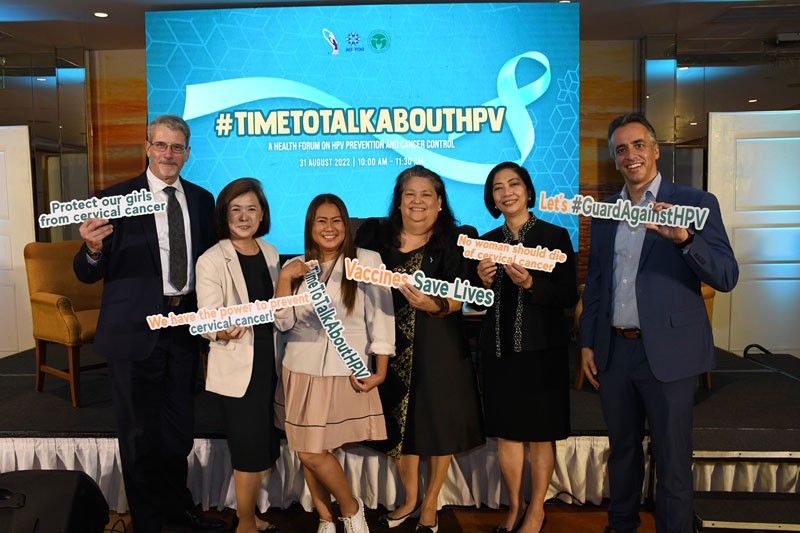Why it’s important to talk to your kids about HPV


When COVID-19 struck, most parents feared that their children might find it difficult to understand what they were seeing online — or hearing from other people about the deadly virus. But having an open, supportive discussion with them helped them understand, cope, and even value the importance of having a healthy body and a sound mind.
And so, why is there so little conversation about sexually transmitted diseases like HPV between parents and their children?
You may have heard about HPV (human papillomavirus) as the virus linked to cervical cancer.
It ranks as the second most frequent cancer among women in the Philippines and the second most frequent cancer among women between 15 and 44 years of age.
However, HPV does not only affect women, but men, too!
“We have been in the middle of an HPV epidemic for quite some time, but it’s kind of a quiet epidemic in so many ways,” noted Dr. Mel Kohn, MSD executive director of medical affairs for vaccines and infectious diseases, during a health forum on HPV prevention and cancer control. “It’s not like COVID, it’s not like the measles. You don’t see HPV (genital warts) immediately when you meet somebody, but the virus is there and has been growing insidiously.”
The good news is that HPV is highly preventable and we can protect our children — as young as nine years old — from acquiring the disease. Yes, even before they become sexually active.
Time to talk about HPV
HPV is a virus that is transmitted through sexual contact. It continues to threaten women and men, including teenagers worldwide.
“HPV is a virus that causes a wide range of diseases,” said Dr. Kohn. “Apart from cervical cancer, the second leading cancer for Filipinas, HPV can give men head and neck cancer, anal cancer for both sexes and a variety of less common, but also devastating kinds of cancers.” Examples are vaginal and vulvar cancers, and penile cancer.
“Genital warts, while it doesn’t kill you, can be quite devastating,” Dr. Kohn added. “It’s quite common, but very difficult to eradicate. Imagine the psychological toll on the patient.”
And so, why should parents with young children be concerned?
“Prevention is always better than cure,” reminded Dr. Anna Lisa Ong-Lim, professor and chief of division of infectious and tropical disease in pediatrics, UP Manila College of Medicine. “HPV should be given to children as young as nine years old. We try to catch that window where the immune system really responds very well to it.”
But more importantly, giving the vaccine at a younger age ensures that they are already protected before they become sexually active.
“HPV vaccines work best when given before exposure to the virus. We must try to catch that window when the immune system really responds very well to it,” explained Dr. Lim.
Teens and young adults through age 26 years, who didn’t start or finish the HPV vaccine series, should also have HPV vaccination. Women up to age 45 may be eligible for vaccination after discussing with their provider.
Dr. Jean Anne Toral, chair of Manila Declaration: Call to Action Against Cervical Cancer and a practicing OB-gynecologist, shared that the young and adult fertility study done recently indicates that the average age Filipina women become sexually active is 18.2 years old.
“Giving the vaccine at age nine to 15 would be beneficial, as there is no life event that exactly pinpoints exposure to HPV apart from age of sexual debut,” she said.
There will be seven to eight out of 10 women who will be exposed to HPV at one point in their life, “But not all women will develop cervical cancer,” Dr. Toral assured. The probability of HPV exposure developing into cancer increases if a patient smokes, is exposed to other sexually transmitted diseases and has HIV.
School-based HPV vaccination
As part of the government’s effort to protect children and adolescents from vaccine-preventable diseases, the Department of Health (DOH), together with partner agencies, rolled out the School-Based Immunization (SBI) Program.
The SBI Program includes measles, rubella, tetanus, diphtheria (MR-TD) and human papillomavirus (HPV) vaccines that are administered to eligible students in public elementary schools. The inclusion of HPV vaccination in the SBI Program aims to protect young women from cervical cancer later in life, among other diseases associated with HPV.
Under the DOH’s SBI Program, HPV vaccination is given to Grade 4 based on the DOH’s recommended age group to receive the two doses of HPV vaccine, six months apart, for protection against cervical cancer.
Prior to administering the vaccine, parents’ consent must first be obtained by school officials. That is why vaccination education campaigns usually highlight the role of parents in fortifying the health shield of their children through timely vaccination against diseases.
Due to the COVID-19 pandemic, the HPV vaccination, which was formerly delivered through the SBI Program, is now being shifted as part of the Community-based Immunization to be able to still deliver HPV vaccination to young girls to protect them against cervical cancer and other HPV-related diseases and cancers.
Towards a cervical cancer-free future
The elimination of cervical cancer has been defined as achieving an incidence rate low enough for the disease to be considered controlled as a public-health problem; this threshold has been defined by the WHO as fewer than four cases per 100,000 women per year.
To accomplish this, every country must reach and maintain three key targets within the lifetime of today’s young generation. The first is for 90 percent of girls to be fully vaccinated against HPV by the age of 15. Second is to ensure that 70 percent of women are screened using a high-performance test by the age of 35, and again by age 45. The final target is for 90 percent of women with pre-cancer to receive treatment and for 90 percent of women with invasive cancer to have their condition properly managed.
Achieving this vision and each of the elimination targets will require a whole-of-society and multi-sectoral approach to ensure health systems prioritize women and girls.
Carmen Auste, chief executive officer of Cancer Warriors Foundation Inc., said that the Philippines is among the countries that declared their commitment together with WHO to finally eradicate cervical cancer in the country by 2040, and by 2030 worldwide. “To attain that goal, we must augment HPV vaccine uptake and educate the Filipinos on HPV, vaccines and cancers caused by HPV,” she said.
At this critical juncture, we must empower women and tap the “Mariteses” in our neighborhood (to spread the word on HPV), and community leaders, LGUs to take action and save thousands of lives.
Together, let’s commit to women everywhere to end cervical cancer.
(From left) MSD Medical Affairs for Vaccines and Infectious Disease executive director Dr. Mel Kohn with Dr. Anna Lisa Ong-Lim, Radio 5 anchor Laila Chikadora, Carmen Auste, Dr. Jean Anne Toral, and MSD Phils. president and managing director Andreas Riedel



















